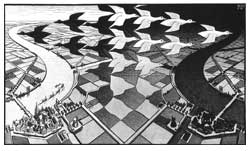|

The Man Who Played with Perceptions
There’s another birthday this week I’d like to celebrate. On June 17, 1898, Maurits Cornelis Escher was born. He was Mauk to his friends. M.C. to the rest of the world.
M.C. Escher was a visionary artist. In the early part of his career, Escher crafted woodcuts, then lithographs, of landscapes he saw in his travels. One of those journeys took him to the Moorish palace, Alhambra, in Spain. The interlocking patterns in the tiles captivated him. He began to wonder if such geometric patterns could be made with organic forms: plants, animals and people. It was this pursuit that made his fame.
|

|
|
Escher is known today for the way his work cleverly tweaks the viewer’s sense of space and reality. Stairs defy gravity; a mobius strip crawls with ants; rooms twist until one is dizzy. In an Escher drawing, one man’s ceiling becomes another man’s floor. In much of his work, the images play with the relationship between positive and negative space.
|
In art, negative space is that area around an object. We often think of it as the background. Most artists strive to make that space visually interesting, but Escher did much more than that. He so interwove the foreground and the background that they switch back and forth, like the age-old question of the stripes on a zebra: black on white or white on black?
To many art critics, it’s a clever trick but not much more. To me, his etchings are an excellent way to learn a fundamental skill of being creative: to be able to shift one’s perspective. To see things differently. It’s so much more than a visual tool. Flexible thinking is essential in life. Sometimes, the most important lessons aren’t in the problem one is facing, but in the space around the problem. Faith grows when the presence of God is found in seemingly empty spaces. Thankfulness thrives with an awareness of the half-full glass.
Kids should love Escher’s etchings for both their precision and their playfulness. (I’ve posted a few, but try to track down a library book to see the range of his work.) In his own words, he said that he couldn’t help “mocking all our unwavering certainties”. It was fun for him turning our perceptions upside-down.
It’s fun for us, too.
Bruce Van Patter
|